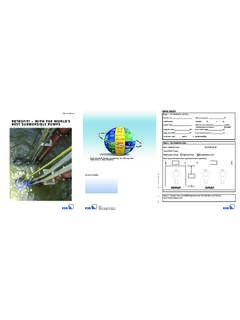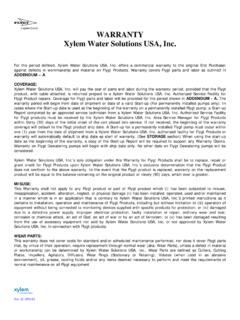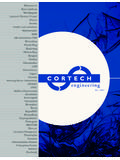Transcription of Fundamentals of Pump Repair - EASA
1 Fundamentals of Pump Repair Introduction Fundamentals of Pump Repair The Repair of the various types of pumps represents an vice and sales personnel who communicate with customers important segment of the service center Repair market. about pump Repair issues. Electric motors and pumps are the two most widely used Section 2 covers Repair concerns and techniques com- industrial machine components. mon to most pumps , while the following sections focus on Although there are two principle pump types (dynamic specific pump types and the unique concerns associated with and positive displacement), this manual focuses on dynamic repairing them.
2 These sections include submersible pumps , pumps and the Fundamentals of dynamic pump Repair . The vertical turbine pumps , end suction pumps and split case information it contains will be helpful to both novice and pumps . Where appropriate, these sections may reference experienced pump Repair technicians, to supervisors and the general Repair information in Section 2. managers of pump Repair operations, and to customer ser- Electrical Apparatus Service Association, Inc. 1331 Baur Boulevard St. Louis, Missouri 63132 USA. 314-993-2220 Engineering Fax 314-993-2998 The information in this book was carefully prepared and is believed to be correct, but EASA makes no warranties respecting it and disclaims any responsibility or liability of any kind for any loss or damage as a consequence of anyone's use of or reliance upon such information.
3 Copyright 2011-2013, Electrical Apparatus Service Association, Inc. (Version 0613) Fundamentals of Pump Repair Table of Contents Table of Contents Section Outline Section 1. General Pump Repair 2. Submersible 3. Vertical Turbine 4. End Suction Radial Split 5. Axial Split-Case 6. 7. Pump 8. Glossary and Standards 9. Copyright 2011-2013, Electrical Apparatus Service Association, Inc. (Version 0613). 1. Fundamentals of Pump Repair Nomenclature Section 1. Nomenclature Section Outline Page Types of positive displacement 1-2. Types of centrifugal 1-3. Submersible pump 1-4. Vertical turbine pump nomenclature Discharge 1-5. Line 1-6.
4 1-7. Axial split-case pump 1-8. End suction radial split-case pump 1-9. Examples of typical 1-9. Copyright 2011-2013, Electrical Apparatus Service Association, Inc. (Version 0613) 1-1. 2. Fundamentals of Pump Repair General Pump Repair Procedures Section 2. General Pump Repair Procedures Section Outline Page 2-3. 2-3. Initial 2-3. 2-3. Cracks in 2-3. Rust or corrosion on bottom of machine 2-3. Shaft looseness/end 2-3. Damaged shaft extension or 2-4. Evidence of long-term oil 2-5. Missing 2-5. Foreign 2-5. Inspect and document ports and seal flush, quench, drain and vent 2-5. 2-5. Locked thrust bearings and 2-5. Removal and reuse of mechanical 2-5.
5 Check shaft straightness when 2-5. Standalone 2-6. Impeller 2-6. pumps with integral 2-7. Cleaning and 2-7. Remove grease and 2-7. Remove 2-7. Protect cleaned 2-8. Check 2-8. Check for evidence of contact or 2-9. Inspect bolts, threaded studs and threaded 2-9. Test for cracks in housings and Copyright 2011-2013, Electrical Apparatus Service Association, Inc. (Version 0613) 2-1. Section 2 General Pump Repair Procedures Fundamentals of Pump Repair Section Outline Page Wear ring Dimensional 2-12. Bearing 2-12. Shaft condition 2-15. Seal 2-15. Corrosion or erosion of impeller housing or 2-16. 2-16. Machine 2-16. 2-34. Rotor 2-35.
6 2-37. 2-37. Rolling bearing 2-38. Test for end-float, runout and 2-38. Seal assembly and 2-38. Assembly 2-39. Final 2-39. Operational 2-39. Pump test 2-40. Closed-loop 2-41. Open-loop 2-41. Measuring head and 2-41. Preventing 2-41. NPSHR tests .. 2-42. Dead-head 2-42. Speed tolerance 2-42. Performance 2-42. Seal cavitity 2-42. Motor cavity pressure 2-43. Vibration 2-43. 2-2 Copyright 2011-2013, Electrical Apparatus Service Association, Inc. (Version 0613). 3. Fundamentals of Pump Repair Submersible pumps Section 3. Submersible pumps Section Outline Page General 3-3. Types of submersible 3-3. 3-3. Lift station flange 3-3. Cooling 3-4.
7 Chopper/sewage 3-5. Oil 3-5. Dry pit 3-5. Deep-well single- and 3-5. Impeller 3-5. Centrifugal impellers and specific 3-5. Open, semi-open, closed and Francis vane 3-6. Macerator or grinder pump 3-6. Single-vane and screw-type 3-7. Vortex pump 3-7. Initial 3-7. Power and control cable 3-8. Suction screen, strainer or suction 3-8. Lifting lugs and mounting 3-8. 3-8. 3-8. Technical note on Flygt impeller 3-10. Electrical Cable Stator core 3-12. 3-12. 3-12. Copyright 2011-2013, Electrical Apparatus Service Association, Inc. (Version 0613) 3-1. Section 3 Submersible pumps Fundamentals of Pump Repair Section Outline Page Cable and cable 3-13.
8 Bearing fit housings, shaft and thrust 3-13. Wear ring 3-13. Rabbet fits and 3-13. Moisture 3-13. 3-14. Mechanical seal concerns .. 3-14. Electrical 3-15. Mechanical 3-15. Repairing/replacing 3-15. 3-16. Impeller clearance 3-16. Cable 3-16. Protective devices and 3-21. 3-21. 3-2 Copyright 2011-2013, Electrical Apparatus Service Association, Inc. (Version 0613). 4. Fundamentals of Pump Repair Vertical Turbine pumps Section 4. Vertical Turbine pumps Section Outline Page Vertical turbine pump 4-2. Initial 4-3. Shaft bottom 4-3. Flush and lube line 4-3. 4-3. Removing corroded/erroded 4-3. Impeller 4-4. Shaft 4-5. Sand 4-5. 4-6. 4-6.
9 Erosion/corrosion 4-6. Rabbet fit 4-8. Cracks detection and 4-8. Bearing 4-8. Impeller 4-9. Impeller 4-9. Shaft 4-9. Shaft enclosing 4-12. 4-13. Copyright 2011-2013, Electrical Apparatus Service Association, Inc. (Version 0613) 4-1. 5. Fundamentals of Pump Repair End Suction Radial Split pumps Section 5. End Suction Radial Split pumps Section Outline Page End suction radial split pump 5-2. Initial 5-2. 5-3. 5-3. 5-3. Bearing fit housings, shaft and thrust 5-3. Wear ring 5-4. Seal or packing 5-4. Cracks in mounting feet or 5-4. Lubrication 5-4. 5-5. 5-5. 5-5. Close-coupled pumps (integral motor).. 5-5. 5-5. 5-5. Adjusting thrust position (axial location).
10 5-5. 5-6. Copyright 2011-2013, Electrical Apparatus Service Association, Inc. (Version 0613) 5-1. 6. Fundamentals of Pump Repair Axial Split-Case pumps Section 6. Axial Split-Case pumps Section Outline Page General 6-2. Impeller 6-2. Initial 6-3. 6-4. Remove seal cavity cover or packing 6-4. Remove casing upper 6-4. Disconnect bearing 6-4. Remove rotating 6-4. Disassemble rotating 6-4. 6-4. Bearing fit 6-4. Wear ring 6-4. Inspect for rubs at close-tolerance fits between rotating element and stationary 6-8. Evaluate shaft 6-8. Thrust 6-8. 6-10. 6-10. Pump 6-10. Seal Mechanical seal 6-12. Seal 6-13. Verify 6-13. Machine the seal housing bore and 6-14.









